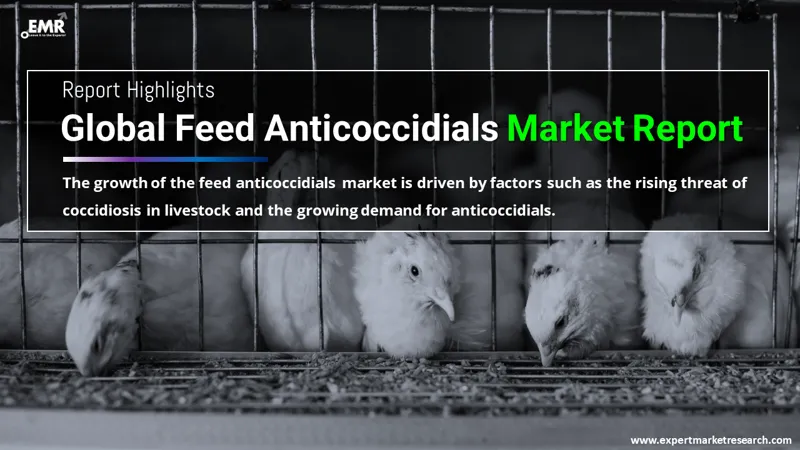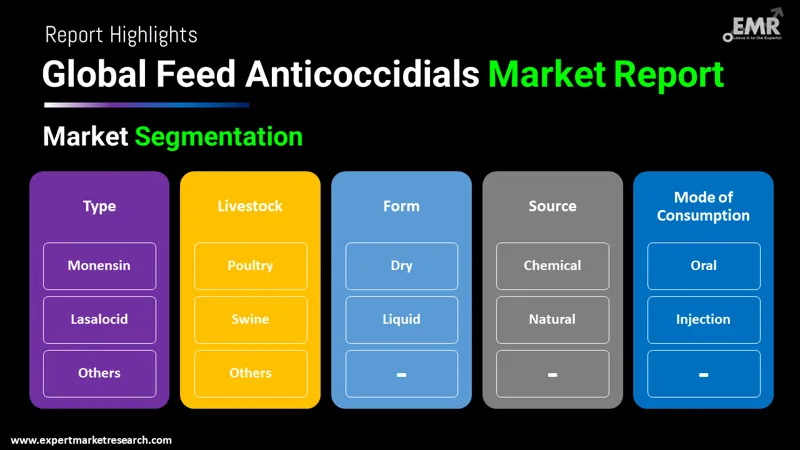
Consumer Insights
Uncover trends and behaviors shaping consumer choices today
Procurement Insights
Optimize your sourcing strategy with key market data
Industry Stats
Stay ahead with the latest trends and market analysis.
The global feed anticoccidials market was valued at USD 389.03 Million in 2025 and is further expected to grow at a CAGR of 4.20% during the forecast period of 2026-2035, reaching a value of USD 587.03 Million by 2035.
Base Year
Historical Period
Forecast Period
Compound Annual Growth Rate
4.2%
Value in USD Million
2026-2035
*this image is indicative*

Read more about this report - REQUEST FREE SAMPLE COPY IN PDF
The global feed anticoccidials industry can be divided based on segments like types, livestock, forms, sources, and mode of consumption.
Based on type, the industry is segmented as:
Based on livestock, the industry can be categorised as:
Based on form, the industry can be segmented as:
Based on the source, the industry can be segmented as:
Based on the mode of consumption, the industry is bifurcated into:
Breakup by Region

Read more about this report - REQUEST FREE SAMPLE COPY IN PDF
The factors attributable to the feed anticoccidials market growth are the increasing threat of coccidiosis in livestock and the increasing demand for anticoccidials from the regions like the Asia Pacific, South America, and the Middle East and Africa.
The Asia Pacific region, with the presence of a huge number of domesticated animals, accounts for a significant share in the global feed anticoccidials market. Further, the region is witnessing increased consumer attention towards animal healthcare owing to the rising awareness about animal health and the growing health expenditure, particularly in emerging nations like India and China, which will provide opportunities for the industry growth. China and India also experienced a significant growth in livestock breeding for meat.
On the other hand, stringent regulations on the usage of chemical anticoccidials in feed products to ensure the sustainability of the feed and livestock chain, particularly in the EU nations, are hampering the industry growth for anticoccidials. However, with the increasing regulations on chemical anticoccidials, the manufacturers are focusing on the use of natural or herbal extracts with anticoccidial property, which is expected to generate growth opportunities for new entrants in the industry over the forecast period.
The report presents a detailed analysis of the following key players in the global feed anticoccidials equipment market, looking into their capacity, competitive landscape, and latest developments like capacity expansions, plant turnarounds, and mergers and acquisitions:
The EMR report gives an in-depth insight into the industry by providing a SWOT analysis as well as an analysis of Porter’s Five Forces model.




*While we strive to always give you current and accurate information, the numbers depicted on the website are indicative and may differ from the actual numbers in the main report. At Expert Market Research, we aim to bring you the latest insights and trends in the market. Using our analyses and forecasts, stakeholders can understand the market dynamics, navigate challenges, and capitalize on opportunities to make data-driven strategic decisions.*
Get in touch with us for a customized solution tailored to your unique requirements and save upto 35%!
Explore our key highlights of the report and gain a concise overview of key findings, trends, and actionable insights that will empower your strategic decisions.
| REPORT FEATURES | DETAILS |
| Base Year | 2025 |
| Historical Period | 2019-2025 |
| Forecast Period | 2026-2035 |
| Scope of the Report |
Historical and Forecast Trends, Industry Drivers and Constraints, Historical and Forecast Market Analysis by Segment:
|
| Breakup by Type |
|
| Breakup by Livestock |
|
| Breakup by Form |
|
| Breakup by Source |
|
| Breakup by Mode of Consumption |
|
| Breakup by Region |
|
| Market Dynamics |
|
| Competitive Landscape |
|
| Companies Covered |
|
| Report Price and Purchase Option | Explore our purchase options that are best suited to your resources and industry needs. |
| Delivery Format | Delivered as an attached PDF and Excel through email, with an option of receiving an editable PPT, according to the purchase option. |
Datasheet
One User
USD 2,499
USD 2,249
tax inclusive*
Single User License
One User
USD 3,999
USD 3,599
tax inclusive*
Five User License
Five User
USD 4,999
USD 4,249
tax inclusive*
Corporate License
Unlimited Users
USD 5,999
USD 5,099
tax inclusive*
*Please note that the prices mentioned below are starting prices for each bundle type. Kindly contact our team for further details.*
Flash Bundle
Small Business Bundle
Growth Bundle
Enterprise Bundle
*Please note that the prices mentioned below are starting prices for each bundle type. Kindly contact our team for further details.*
Flash Bundle
Number of Reports: 3
20%
tax inclusive*
Small Business Bundle
Number of Reports: 5
25%
tax inclusive*
Growth Bundle
Number of Reports: 8
30%
tax inclusive*
Enterprise Bundle
Number of Reports: 10
35%
tax inclusive*
How To Order

Select License Type
Choose the right license for your needs and access rights.

Click on ‘Buy Now’
Add the report to your cart with one click and proceed to register.

Select Mode of Payment
Choose a payment option for a secure checkout. You will be redirected accordingly.
Gain insights to stay ahead and seize opportunities.

Get insights & trends for a competitive edge.

Track prices with detailed trend reports.

Analyse trade data for supply chain insights.

Leverage cost reports for smart savings

Enhance supply chain with partnerships.

Connect For More Information
Our expert team of analysts will offer full support and resolve any queries regarding the report, before and after the purchase.
Our expert team of analysts will offer full support and resolve any queries regarding the report, before and after the purchase.
We employ meticulous research methods, blending advanced analytics and expert insights to deliver accurate, actionable industry intelligence, staying ahead of competitors.
Our skilled analysts offer unparalleled competitive advantage with detailed insights on current and emerging markets, ensuring your strategic edge.
We offer an in-depth yet simplified presentation of industry insights and analysis to meet your specific requirements effectively.
Share